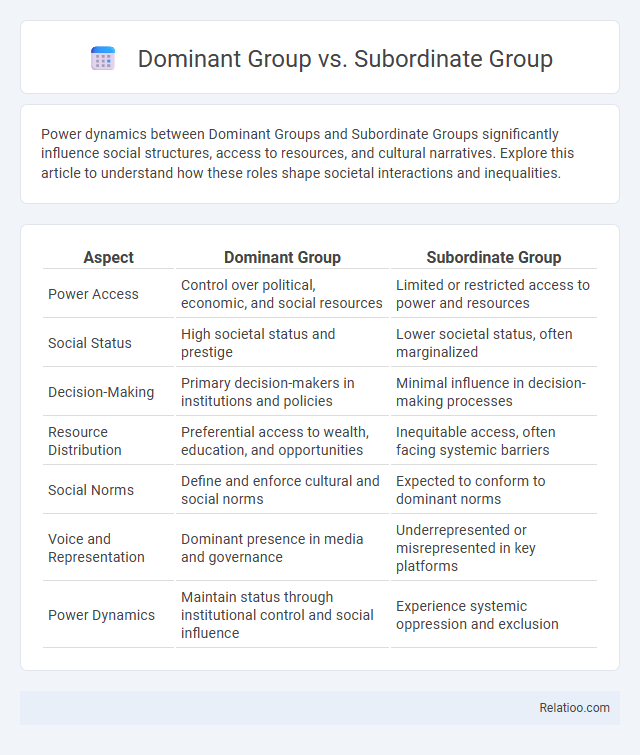Power dynamics between Dominant Groups and Subordinate Groups significantly influence social structures, access to resources, and cultural narratives. Explore this article to understand how these roles shape societal interactions and inequalities.
Table of Comparison
| Aspect | Dominant Group | Subordinate Group |
|---|---|---|
| Power Access | Control over political, economic, and social resources | Limited or restricted access to power and resources |
| Social Status | High societal status and prestige | Lower societal status, often marginalized |
| Decision-Making | Primary decision-makers in institutions and policies | Minimal influence in decision-making processes |
| Resource Distribution | Preferential access to wealth, education, and opportunities | Inequitable access, often facing systemic barriers |
| Social Norms | Define and enforce cultural and social norms | Expected to conform to dominant norms |
| Voice and Representation | Dominant presence in media and governance | Underrepresented or misrepresented in key platforms |
| Power Dynamics | Maintain status through institutional control and social influence | Experience systemic oppression and exclusion |
Understanding Dominant and Subordinate Groups
Dominant groups hold social, economic, and political power that shapes societal norms and access to resources, while subordinate groups face systemic barriers and marginalization due to unequal power dynamics. Understanding these roles involves recognizing how dominant groups maintain privilege through institutional structures, often leading to the oppression of subordinate groups. Your awareness of these distinctions is essential in addressing social inequalities and promoting equity.
Historical Context of Power Dynamics
Dominant groups have historically maintained power by controlling political, economic, and social institutions, often marginalizing subordinate groups through systemic discrimination and exclusion. Subordinate groups experience oppression manifested in restricted access to resources, diminished social status, and limited opportunities for upward mobility. This dynamic is evident in contexts such as colonialism, slavery, and apartheid, where institutionalized power imbalances entrenched systemic inequalities.
Characteristics of Dominant Groups
Dominant groups possess greater access to resources, power, and social privileges compared to subordinate groups, enabling them to influence societal norms and institutions. These groups maintain their status through systemic advantages, often perpetuating discrimination and inequality that oppress subordinate groups. Understanding the characteristics of dominant groups can help you recognize patterns of oppression and advocate for social justice.
Traits and Experiences of Subordinate Groups
Subordinate groups often face systemic disadvantages that limit their access to resources, opportunities, and social power compared to dominant groups. These groups frequently experience discrimination, marginalization, and unequal treatment rooted in societal norms and institutional practices. The traits of subordinate groups include resilience and cultural distinctiveness, shaped by their shared experiences of oppression and resistance.
Mechanisms of Social Control and Marginalization
Dominant groups exert social control through mechanisms such as institutional policies, cultural norms, and economic power, which systematically marginalize subordinate groups by limiting access to resources and opportunities. These processes reinforce social hierarchies by legitimizing discrimination, restricting political influence, and perpetuating stereotypes that devalue marginalized identities. Marginalization results in reduced social mobility and exclusion from societal participation, maintaining dominance and oppression across social, economic, and political spheres.
The Role of Privilege and Access
Dominant groups possess systemic privilege and greater access to economic, political, and social resources, reinforcing their ability to shape norms and maintain power structures. Subordinate groups face restricted access and experience barriers that limit opportunities, leading to disparities in wealth, education, and representation. This dynamic of privilege and restricted access perpetuates oppression by sustaining inequalities and consolidating dominance within societal institutions.
Impact on Identity and Self-Perception
Dominant groups shape societal norms and values, influencing Your identity by reinforcing traits aligned with their cultural standards, often marginalizing subordinate groups. Subordinate groups frequently experience internalized oppression, leading to diminished self-esteem and conflicted self-perception as their cultural identity clashes with dominant expectations. Oppression perpetuates systemic inequalities that distort self-worth and limit access to opportunities for identity expression and validation.
Intersectionality Within Social Hierarchies
Intersectionality within social hierarchies reveals how dominant groups maintain power by intersecting identities such as race, gender, and class, creating complex systems of oppression for subordinate groups. Your experience may be shaped by overlapping social categories that influence access to resources and exposure to discrimination. Recognizing these intersecting social identities is crucial for addressing systemic inequalities and promoting social justice.
Strategies for Challenging Dominance
Strategies for challenging dominance involve empowering subordinate groups through community organizing, education, and advocacy to raise awareness about systemic inequalities. Implementing policies that promote equity, such as affirmative action and anti-discrimination laws, helps to dismantle structures that maintain the dominant group's power. Grassroots movements and intersectional alliances strengthen resistance by fostering solidarity and amplifying marginalized voices against oppression.
Pathways Toward Social Equity
Dominant groups possess systemic power and resources that perpetuate social hierarchies, while subordinate groups face structural barriers and limited access to opportunities. Oppression manifests through discriminatory policies, cultural marginalization, and economic inequalities that maintain dominance and hinder social mobility. Pathways toward social equity involve dismantling systemic barriers, implementing inclusive policies, promoting representation, and fostering equitable access to education, healthcare, and economic resources.

Infographic: Dominant Group vs Subordinate Group
 relatioo.com
relatioo.com